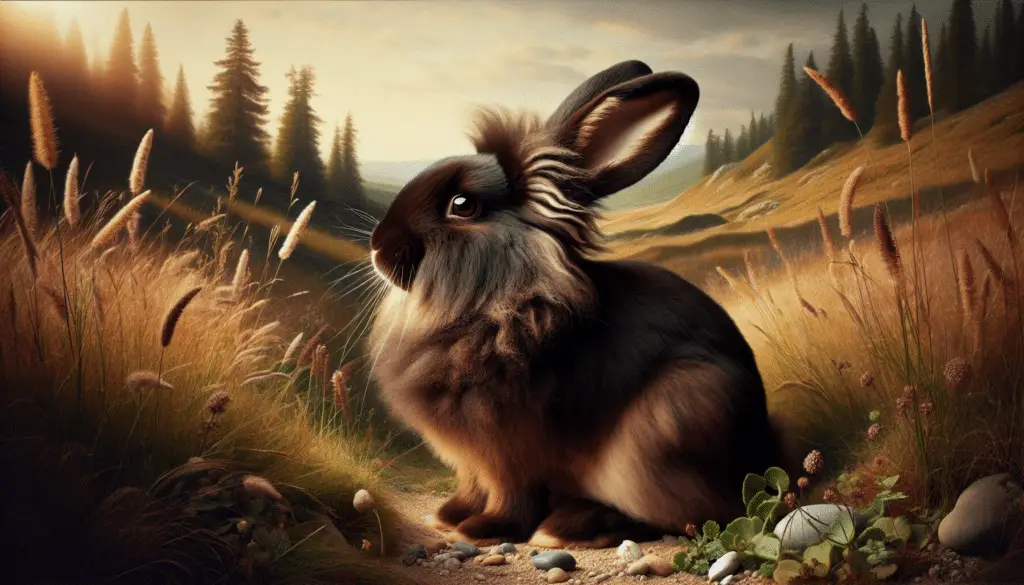An Introduction to Sable Rabbits
Table of Contents
ToggleSable rabbits are a distinctive and attractive breed known for their rich, dark fur and friendly temperament.
Originally bred for their unique coat coloration, sable rabbits have become increasingly popular as pets and show animals.
Before diving into detailed aspects of their lives, let’s start by answering your most pressing question.
What Makes Sable Rabbits Unique?
Their unique and luxurious fur, which has a rich, dark sable color, makes sable rabbits easily distinguishable.
Physical Characteristics of Sable Rabbits
Sable rabbits have a distinctive appearance that sets them apart from other rabbit breeds.
They have a medium-sized body, often weighing between five and eight pounds.
A male sable rabbit, or buck, tends to be slightly larger than the female, or doe.
Their coat is characterized by a dark brown to black color, with some rabbits exhibiting lighter shades of brown that create a stunning contrast.
Their eyes are typically dark and expressive, adding to their captivating look.
Habitat and Environment
Sable rabbits are versatile animals that adapt well to various environments.
They can thrive both indoors and outdoors, provided they have a safe and comfortable hutch.
If housed outdoors, ensure the hutch protects them from harsh weather conditions and predators.
They enjoy a spacious environment where they can hop around, burrow, and explore.
Regular exercise and mental stimulation are vital for their well-being.
Natural Diet and Feeding Habits
The diet of sable rabbits largely consists of hay, vegetables, and high-quality pellets.
Hay should make up the majority of their diet, providing essential fiber for their digestive health.
Fresh vegetables such as kale, carrots, and bell peppers can be offered as occasional treats.
It’s important to avoid sugary or starchy foods, as these can lead to digestive issues.
A clean, constant supply of fresh water is essential for their hydration needs.
Breeding and Reproduction
Sable rabbits reach sexual maturity relatively early, usually around six months of age.
A doe can have multiple litters each year, with each litter consisting of four to eight kits.
The gestation period for a sable rabbit is typically around 30 days.
Proper care and nutrition for the doe are paramount during and after pregnancy to ensure the health of both the mother and kits.
Behavior and Social Interaction
Sable rabbits are known for their gentle and friendly nature, making them excellent pets for families.
They are social creatures that enjoy interaction and can form strong bonds with their owners.
Providing toys and activities to keep them mentally stimulated can help prevent boredom and encourage healthy behavior.
Regular handling and socialization from a young age can help them become well-adjusted adults.
Predators and Protection
Like most rabbits, sable rabbits have several natural predators, including foxes, hawks, and snakes.
It’s crucial to provide a secure living environment to protect them from potential threats.
Using predator-proof fencing and ensuring their hutch is sturdy and escape-proof can help keep them safe.
If you keep them outdoors, bringing them inside at night can further enhance their safety.
Are Sable Rabbits Endangered?
Sable rabbits are not an endangered species.
However, their population must be managed responsibly to prevent overbreeding and homelessness.
Always adopt from reputable breeders or rescue organizations to ensure the continued well-being of these charming animals.
Relation to Other Rabbit Species
Sable rabbits are a domesticated breed and share many traits with other common rabbit breeds.
They can be crossbred with other rabbits, although this may result in variations in coat color and other physical attributes.
Understanding their specific needs and characteristics can help you provide the best care possible.
Health and Common Ailments
Like all rabbits, sable rabbits are prone to specific health issues, including dental problems and gastrointestinal stasis.
Regular veterinary check-ups are essential to monitor their overall health and catch any issues early.
Vaccinations and parasite control can prevent common diseases, such as myxomatosis and rabbit hemorrhagic disease.
Keeping their living environment clean and providing a balanced diet can go a long way in ensuring their well-being.
Frequently Asked Questions About Sable Rabbits
What is the lifespan of a sable rabbit?
Sable rabbits typically live between 7 to 10 years, although with proper care, some can live even longer.
Are sable rabbits easy to train?
Sable rabbits can be trained with patience and positive reinforcement, especially when it comes to litter training.
Can sable rabbits live with other pets?
It depends on the other pets in your household. They can coexist peacefully with other rabbits or small animals, but supervision is necessary around dogs and cats.
How often should I groom a sable rabbit?
Regular grooming is essential to prevent matting and keep their coat in good condition. Brush them at least once a week.
What type of housing is best for sable rabbits?
A spacious hutch with a secure, comfortable area for sleeping and hiding is ideal. Ensure it is weatherproof if kept outdoors.
Do sable rabbits need any specific toys?
Interactive and chew toys designed for rabbits can provide mental stimulation and prevent boredom.
What is the best diet for a sable rabbit?
A diet consisting mainly of hay, supplemented with fresh vegetables and high-quality pellets, is ideal.
How can I tell if my sable rabbit is healthy?
Signs of a healthy rabbit include bright eyes, a shiny coat, and regular eating and grooming habits.
What should I do if my sable rabbit shows signs of illness?
If you notice any signs of illness, such as loss of appetite, lethargy, or unusual behavior, consult a veterinarian promptly.
Can sable rabbits be kept as indoor pets?
Yes, sable rabbits can be kept indoors. Just ensure they have a safe, rabbit-proofed area to roam and play.
Additional Insights and Care Tips for Sable Rabbits
Understanding the nuances of sable rabbit care goes beyond just the basics.
Before bringing one home, it’s crucial to delve into details that ensure a happy and healthy life for these charming pets.
Physical Characteristics
Delving deeper into their physical traits, sable rabbits have dense, velvety fur that feels luxurious to the touch.
Their ears are upright and can be quite expressive, often giving clues to their mood and well-being.
A notable feature is their compact yet muscular build, which allows them a blend of agility and sturdiness.
The coat’s coloration can vary slightly, with some showing a more pronounced gradient of sable tones.
Habitat and Environmental Needs
Indoor housing should include a spacious, well-ventilated cage with a solid floor.
Bedding material should be soft, absorbent, and changed frequently to maintain cleanliness.
A designated play area protected from hazards is essential for their physical and mental stimulation.
If you live in a region with extreme weather, keeping sable rabbits indoors is advisable to protect them from temperature fluctuations.
Always provide hiding spots and tunnels within their environment to replicate their natural burrowing instincts.
Feeding Frequency and Special Dietary Requirements
Sable rabbits should have constant access to fresh hay, making up 70-80% of their diet.
Vegetables should be introduced gradually and monitored to avoid gastrointestinal upset.
Fruits can be given sparingly as treats due to their high sugar content.
Ensure the pellets are specifically formulated for rabbits and are of high quality.
Offer a variety of greens to ensure a well-rounded intake of nutrients.
Breeding Cycle and Care for Kits
During the breeding season, bucks may exhibit more territorial behavior.
Does will prepare a nest using their fur and available bedding materials.
After giving birth, it’s crucial to minimize disturbances to avoid stressing the mother and kits.
Monitor the doe’s health closely during lactation, ensuring she receives enough nutrition to support her increased energy demands.
Behavioral Traits and Interaction
Sable rabbits thrive on social interaction and may become lonely if left alone for extended periods.
They enjoy gentle petting and may even nudge you for attention.
Always handle them gently, supporting their hindquarters to prevent injury.
Introduce them to new environments slowly to avoid overwhelming them.
Encourage play with a variety of toys to stimulate their curiosity and keep them engaged.
Safety Measures and Predator Prevention
Use double-layered fencing if you keep them outdoors to deter burrowing predators.
Raising the hutch off the ground can help prevent access by many common predators.
Regularly inspect the hutch for any weak points or damaged areas.
Consider adding motion-activated lights near the hutch to scare away nocturnal predators.
Health Maintenance and Veterinary Care
Regular grooming helps prevent fur mats and allows you to check for skin issues.
Brush their coat more frequently during shedding seasons to reduce hair ingestion.
Check their teeth regularly as overgrown teeth can lead to eating difficulties.
Ensure a balanced diet to avoid obesity and related health problems.
Spot clean any soiled areas in their living space daily and thoroughly clean weekly.
Parasite prevention, such as regular deworming, is essential for their overall health.
Interesting Facts About Sable Rabbits
Sable rabbits have a calm demeanor, making them a favorite for therapy animals.
Their unique coat coloration is due to a specific gene, the sable or “chinchilla” gene.
Despite their luxurious fur, they are relatively low-maintenance compared to other long-haired rabbit breeds.
They often enjoy interactive toys like tunnels, balls, and puzzle feeders.
Sable rabbits are intelligent and can be taught simple tricks with positive reinforcement.
Common Myths About Sable Rabbits
Are sable rabbits high-maintenance due to their fur?
While they need regular grooming, they are not considered high-maintenance.
Do sable rabbits require special diets?
They follow the same dietary guidelines as other rabbit breeds but require high fiber intake.
Can sable rabbits be left alone during the day?
It’s best to avoid leaving them alone for long periods as they are social animals.
Are sable rabbits aggressive?
They are generally gentle but may become defensive if not handled properly.
Do sable rabbits require a large living space?
They need ample space to move, hop, and explore to stay healthy and happy.
Bonding with Your Sable Rabbit
Spend time sitting quietly with your rabbit to let them get used to your presence.
Offer treats from your hand to build trust and reinforce positive behavior.
Speak to them in a gentle, soothing tone to reassure them.
Observe their body language to understand their comfort levels and preferences.
Introduce new toys and activities gradually to keep them engaged.
Practice patience and consistency in your interactions to establish a strong bond.
Ensuring a Long and Happy Life
Regular veterinary check-ups are essential to catch health issues early and administer vaccinations.
Creating a stress-free environment and providing mental stimulation are key to their well-being.
Balanced nutrition and proper hydration can prevent many common health problems.
Encouraging safe play and physical activity helps keep their muscles strong and improves their overall health.
Being attentive to their needs and forming a strong bond can lead to a fulfilling relationship with your sable rabbit.
Connecting with Other Rabbit Enthusiasts
Joining local or online rabbit communities can provide valuable insights and support.
Participating in rabbit shows and events is a great way to meet fellow rabbit lovers.
Sharing experiences and tips can enhance your knowledge and improve your rabbit’s care.
Finding a mentor or experienced rabbit owner can guide you in troubleshooting and growing your understanding.
Frequently Asked Questions About Sable Rabbits
What are common health issues in sable rabbits?
Common health issues include dental problems, gastrointestinal stasis, and respiratory diseases.
Can sable rabbits be trained?
Yes, with patience and positive reinforcement, they can learn basic commands and litter training.
How much exercise do sable rabbits need daily?
They need at least three to four hours of exercise daily to stay healthy and prevent obesity.
What types of hay are best for sable rabbits?
Timothy hay, orchard grass, and meadow hay are excellent options for their diet.
Can sable rabbits live with other rabbits?
Yes, they can be socialized to live with other rabbits, but gradual introductions are important to prevent conflicts.
What are signs of a happy and healthy sable rabbit?
Signs include regular grooming, active behavior, bright eyes, and a healthy appetite.
How often should I clean my sable rabbit’s living area?
Daily spot cleaning is recommended, with a thorough cleaning weekly to maintain hygiene.
What should I do in an emergency health situation with my sable rabbit?
Contact a veterinarian immediately and keep an emergency kit with essential supplies on hand.
Are sable rabbits suitable for homes with children?
Yes, their gentle nature makes them suitable for families, but supervision is needed to ensure proper handling.



